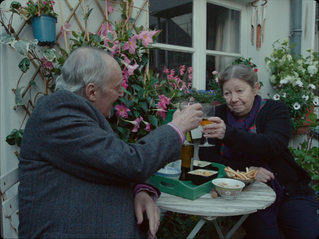Closer
- Anjum Nahar
- Feb 5, 2022
- 3 min read
Mike Nichols, 2004

A busy strip club in the early noughties. The walls are silver, quilted, and the heavy chandeliers are enclosed in red acrylic casing so that they glow orange. The floors of the platforms on which the girls dance are illuminated by an equally blinding pink. Smoke drifts across the various stages, and blue spotlights beam from above. The faces of the punters, still in their business suits, are dappled by all of these strobing colours. ‘World Outside’ by The Devlin’s plays in the background. It’s the perfect lyrical accompaniment. You’re lighting up my dreams, light up my skin, they sing.
The camera hones in on a woman perched at the edge of a stage until only her portrait is in view. In her candy-floss coloured wig, she turns to you, just for a second. Lips parted and eyes brimming with recognition. Suddenly all of these lights become just that little bit brighter. Until she looks away.
*
Portraiture is at the heart of Mike Nichols’ 2004 Closer. Anna, one of the film's four protagonists, is a photographer striving to capture that ‘one shot’. The scene described above may not be one of Anna’s own photographs, but it mirrors, quite exactly in terms of framing, a portrait of Alice (the pink-wigged dream girl, played by Natalie Portman) that she exhibits earlier in the film. Anna’s photograph shows a brunette Alice with tear-stained cheeks, forlorn after realising that her partner Dan is poised to leave her. The differences in affect captured by these two shots demonstrate Alice’s character development, from a girl who craves and desires love, and is governed by this need, to a woman who wields her seductive power over others.
When Alice-at-the-strip-club appears on screen, one can’t help but invoke John Berger’s acute and widely-revered observation that ‘men act and women appear. Men look at women. Women watch themselves being looked at’. When Alice turns her head, she is not simply acknowledging Larry, another of the four protagonists, but rather, she is making an evaluation of her own positionality in the world. This shot is exquisite to me because it is more than just an actualisation of what Laura Mulvey famously termed ‘the male gaze’. Nichols’ sharp cinematography, Patrick Marber’s dexterous plot-formulation, and Portman’s delicate control over her facial expressions elevate this one scene above just merely a pin-up or glamour shot, which is what it so easily could have been. Instead, it is an enviable assertion of authority and control.
That is not to say that this re-establishing of power is straightforward for Alice. Even after leaving Dan, she lives at the precarious edge; precariously employed, precarious in love. As a viewer, it is hard not to pity her. And the beauty of the Alice-at-the-strip-club shot becomes all the more poignant when considered in light of the character’s own musings on photography. At Anna’s exhibition, Larry asks Alice what she thinks of the work. Alice replies:
‘It’s a lie. It’s a bunch of sad strangers photographed beautifully and all the glittering assholes who appreciate art say it’s beautiful because that’s what they wanna see. But the people in the photos are sad…. and alone but the pictures make the world seem beautiful so the exhibition’s reassuring, which makes it a lie… and everyone loves a big fat lie.’
It is too easy, when presented with Alice-at-the-strip-club, to take the character’s presentation of herself at face value, and to forget that it is a fiction within a fiction. Alice’s remarks to Larry reveal that she is frustrated and disillusioned with the highly constructed and filtered nature of portraiture. Alice believes that Anna’s photo values her beauty over the reality of her sadness. In Alice’s perspective, affect trumps aesthetic. Alice urges us to search for reality and context when examining an image. This is her instruction to the viewer as to how to interpret the Alice-at-the-strip-club scene so as not to become one of those ‘glittering assholes’. This one shot from Closer is so potent because it evades any simple reading, and demonstrates the power of a carefully-crafted persona.
*
Despite there being much game-playing in Closer, there are no winners. Dan is left alone and deceived, Anna has settled, Larry has forfeited his integrity and Alice is back where she started. But Alice’s small moments of empowerment are her consolation prize. It is precisely the glory of these moments which puts the spring in her step as she marches through the streets of New York in the film’s final scene.








Comments